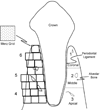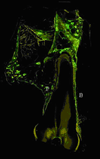Remodeling dynamics in the alveolar process in skeletally mature dogs
- PMID: 17075846
- PMCID: PMC2612758
- DOI: 10.1002/ar.a.20396
Remodeling dynamics in the alveolar process in skeletally mature dogs
Abstract
Bone turnover rates can be altered by metabolic and mechanical demands. Due to the difference in the pattern of loading, we hypothesized that there are differences in bone remodeling rates between the maxillary and mandibular alveolar processes. Furthermore, in a canine model, the alveolar process of teeth that lack contact (e.g., second premolars) would have a different turnover rate than bone supporting teeth with functional contact (e.g., first molars). Six skeletally mature male dogs were given a pair of calcein labels. After sacrifice, specimens representing the anterior and posterior locations of both jaws were prepared for examination by histomorphometric methods to evaluate the bone volume/total volume (BV/TV; %), bone volume (mm2), mineral apposition rate (MAR; microm/day), and bone formation rate (BFR; %/year) in the alveolar process. There were no significant differences (P>0.05) in the BV/TV within the jaws. The bone volume within the alveolar process of the mandible was 2.8-fold greater than in the maxilla. The MAR was not significantly different between the jaws and anteroposterior locations. However, the BFR was significantly (P<0.0001) greater in the mandible than in the maxilla. The anterior location had higher (P=0.002) remodeling than the posterior location in the maxilla but not in the mandible. While there was a greater bone mass and increased remodeling in the mandible, no remodeling gradient in the coronal-apical direction was apparent in the alveolar process. Bone adaptation probably involves a complex interplay of bone turnover, mass, and architecture.
Copyright (c) 2006 Wiley-Liss, Inc.
Figures



References
-
- Anderson C, Danylchuk KD. Age-related variations in cortical bone-remodeling measurements in male Beagles 10 to 26 months of age. Am J Vet Res. 1979a;40:869–872. - PubMed
-
- Anderson C, Danylchuk KD. Appositional bone formation rates in the Beagle. Am J Vet Res. 1979b;40:907–910. - PubMed
-
- Boivin G, Meunier PJ. Changes in bone remodeling rate influence the degree of mineralization of bone. Connect Tissue Res. 2002;43:535–537. - PubMed
-
- Boretti G, Bickel M, Geering AH. A review of masticatory ability and efficiency. J Prosthet Dent. 1995;74:400–403. - PubMed
-
- Bryant HN, Russell AP. Carnassial functioning in nimravid and felid sabertooths: theroetical basis and robustness of inferences. In: Thomason J, editor. Functional morphology in vertebrate paleontology. New York, NY: Cambridge University Press; 1995. pp. 116–135.
Publication types
MeSH terms
Substances
Grants and funding
LinkOut - more resources
Full Text Sources

